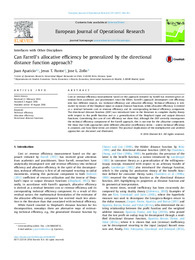Por favor, use este identificador para citar o enlazar este ítem:
https://hdl.handle.net/11000/4935
Can Farrell’s allocative efficiency be generalized by the directional distance function approach?.
Título :
Can Farrell’s allocative efficiency be generalized by the directional distance function approach?. |
Autor :
Aparicio, Juan 
Pastor Ciurana, Jesús Tadeo
ZofÍo, José L. |
Departamento:
Departamentos de la UMH::Estadística, Matemáticas e Informática |
Fecha de publicación:
2016-08-10 |
URI :
http://hdl.handle.net/11000/4935 |
Resumen :
Cost or revenue efficiency measurement based on the approach initiated by Farrell has received great at- tention from academics and practitioners since the fifties. Farrell’s approach decomposes cost efficiency into two different sources, viz. technical efficiency and allocative efficiency. Technical efficiency is esti- mated by means of the Shephard input or output distance functions, while allocative efficiency is derived as a residual between cost or revenue efficiency and its corresponding technical efficiency component. The directional distance function ( DDF ) was introduced later in the literature to complete duality theory with respect to the profit function and as a generalization of the Shephard input and output distance functions. Considering the case of cost efficiency we show that, although the DDF correctly encompasses the technical efficiency component of the Farrell approach, this is not true for the allocative component. We show that both approaches yield different allocative (in)efficiency terms –unless technical efficiency is assumed, and how these terms are related. The practical implications of the multiplicative and additive approaches are discussed and illustrated.
|
Palabras clave/Materias:
Technical efficiency
Allocative efficiency
Directional distance functions |
Tipo de documento :
info:eu-repo/semantics/article |
Derechos de acceso:
info:eu-repo/semantics/openAccess |
Aparece en las colecciones:
Artículos Estadística, Matemáticas e Informática
|
 La licencia se describe como: Atribución-NonComercial-NoDerivada 4.0 Internacional.
La licencia se describe como: Atribución-NonComercial-NoDerivada 4.0 Internacional.
 La licencia se describe como: Atribución-NonComercial-NoDerivada 4.0 Internacional.
La licencia se describe como: Atribución-NonComercial-NoDerivada 4.0 Internacional.
.png)
